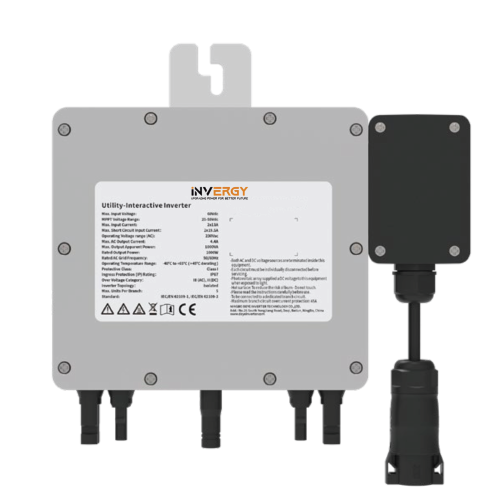MICROINVERTER


Module Level optimisation

Safety & reliability for Indian sites

High Conversion Efficiency

Flexible monitoring and grid compliance

Easy installation & low maintenance
Product Details
iNVERGY Microinverter INV-M100M2-700 – Smart Solar Microinverter for Residential & Small Commercial Roofs
Overview
The iNVERGY Microinverter INV-M100M2-700 is a high-performance, module-level solar microinverter designed to maximise energy harvest from each solar panel and enable safe, efficient grid-tie installations across rooftops in India. With a compact footprint, robust design for Indian climatic conditions, and seamless integration with modern PV modules, this microinverter offers an intelligent solution for homeowners and small commercial deployers.
Key Features
-
Module-level optimisation: Unlike traditional string inverters, the INV-M100M2-700 attaches under individual PV panels, enabling higher yields even in partially shaded or complex roof layouts.
-
High conversion efficiency: Designed to deliver excellent performance in real-world operating conditions – ensuring maximum usable AC output from each module.
-
Easy installation & low maintenance: Lightweight, plug-and-play design makes installation faster, simplifying wiring and reducing labour cost.
-
Safety & reliability for Indian sites: Built with IP-rated enclosure for outdoor mounting, wide ambient temperature tolerance (high heat, dust, humidity), and protection features such as DC anti-islanding, surge protection, and module-level shutdown capability.
-
Flexible monitoring and grid compliance: Supports module-level performance monitoring and meets India’s grid-tie standards, making it suitable for net-metering and export-oriented systems.
Technical Highlights
(Refer to datasheet for detailed specifications.)
Why Choose the iNVERGY Microinverter?
-
Optimised yield on even complex or partially shaded roofs: With module-level handling, each panel works independently rather than being limited by the weakest panel in a string.
-
Reduced installation complexity for residential systems: Quick mounting, simple wiring and fewer constraints on module orientation and layout.
-
Enhanced safety: Module-level shutdown capability and compliance with roof-top safety regulations improve installer and homeowner confidence.
-
Future-ready for micro-grid and export scenarios: As rooftop solar export gets increasingly regulated in India, microinverters provide built-in flexibility for monitoring and grid interaction.
-
Perfect for small commercial & residential: Ideal for homes, villas, small offices, and institutions where roof space is constrained or shading exists, and where maximum yield per panel is valuable.
Application Scenarios
-
Residential rooftop systems (3 kW to 10 kW) where ease of installation and maximum panel-yield matter.
-
Villas and high-end homes in India seeking aesthetic modular solar solutions with minimal wiring clutter.
-
Small commercial buildings with rooftop solar that may face partial shading or varied orientation.
-
Systems where module-level monitoring, export tracking or occupant awareness of generation is desired.
Installation & Maintenance Notes
-
Mount microinverter as close as feasible to the panel to minimise DC cable length and losses.
-
Ensure the ambient temperature range is as specified in the datasheet and that the enclosure remains ventilated.
-
Confirm module compatibility (voltage, power-rating) with the INV-M100M2-700 and ensure the installation complies with local grid-tie / net-metering norms.
-
Use manufacturer’s approved monitoring or communication modules if module-level performance tracking is required.
-
Arrange periodic checks for dust accumulation, wiring integrity and firmware/communication updates (if applicable).
